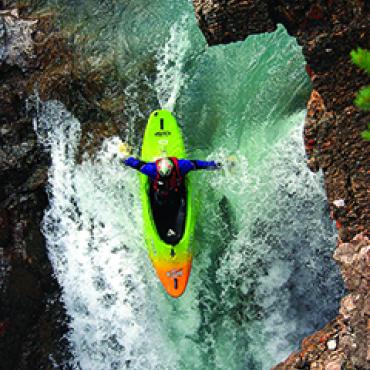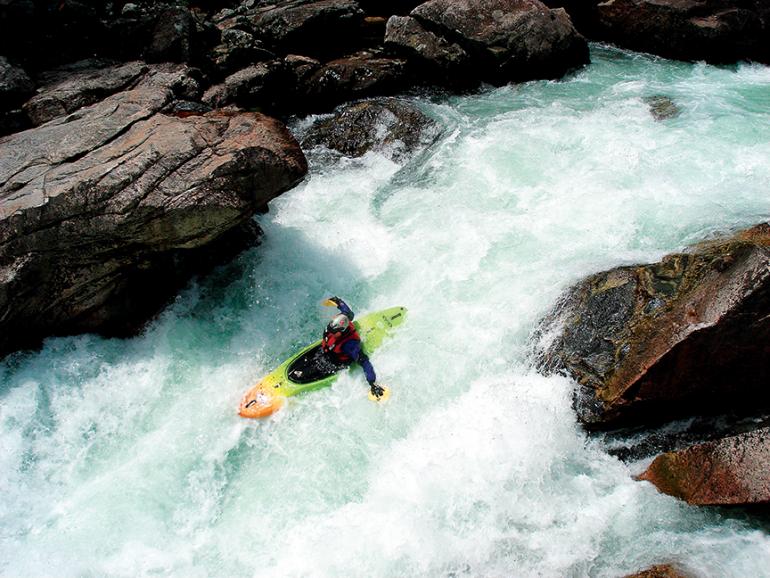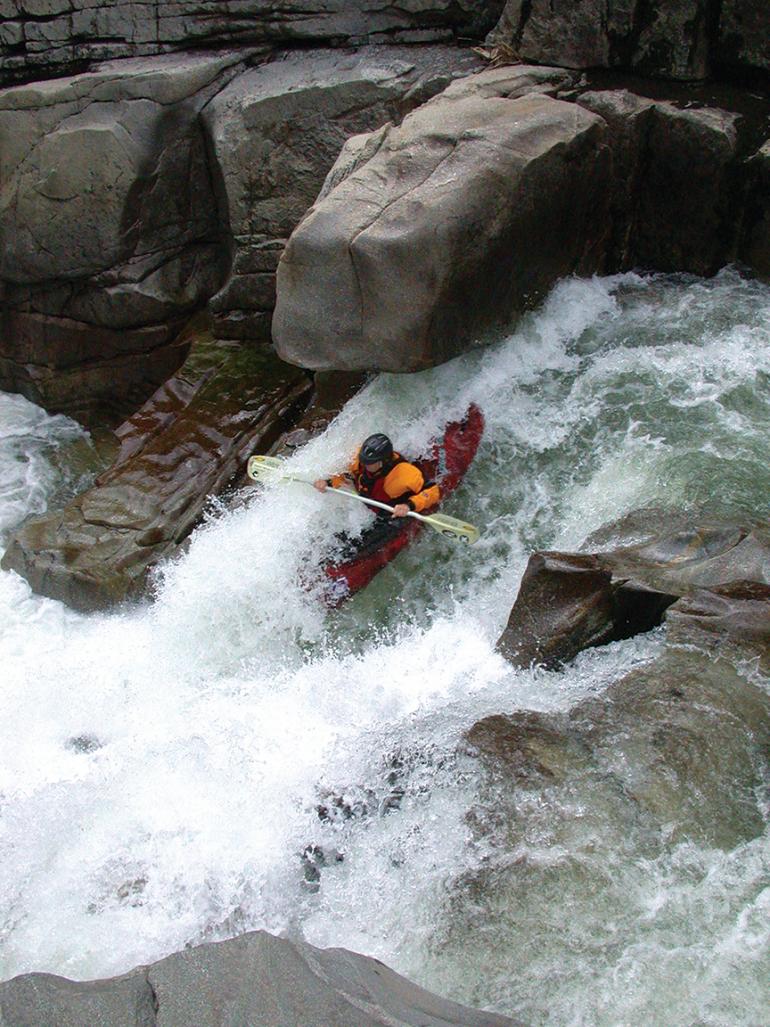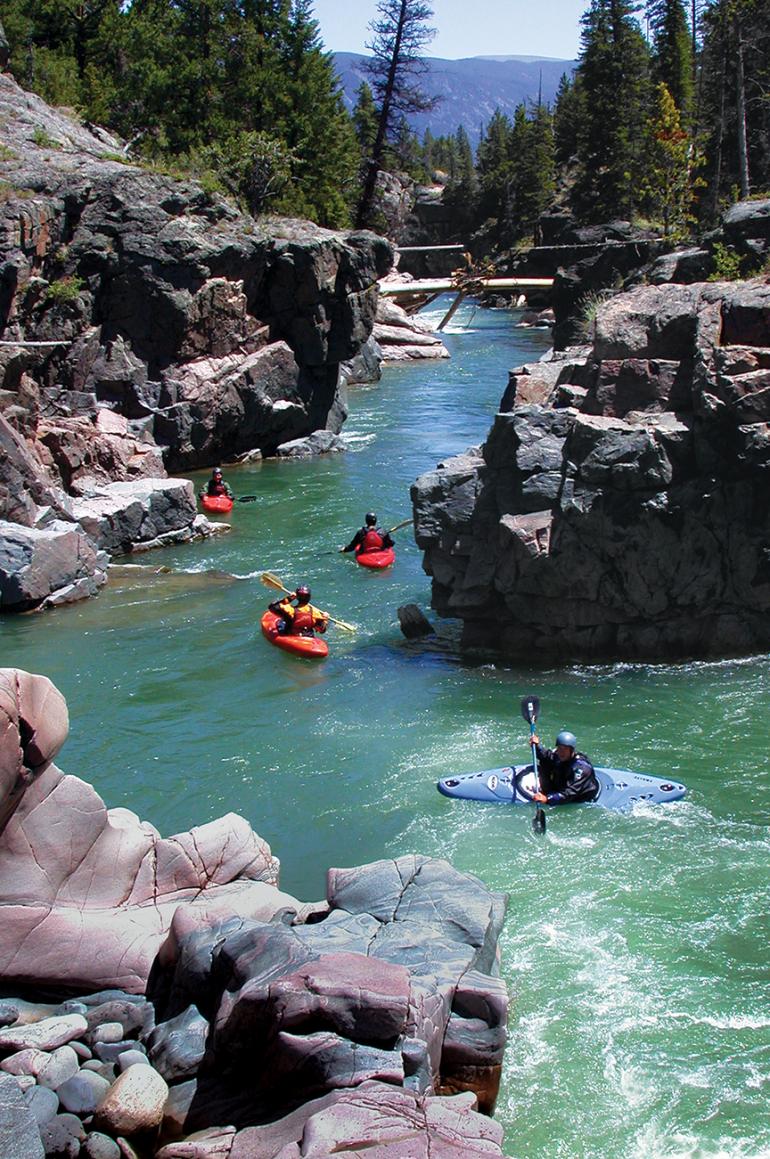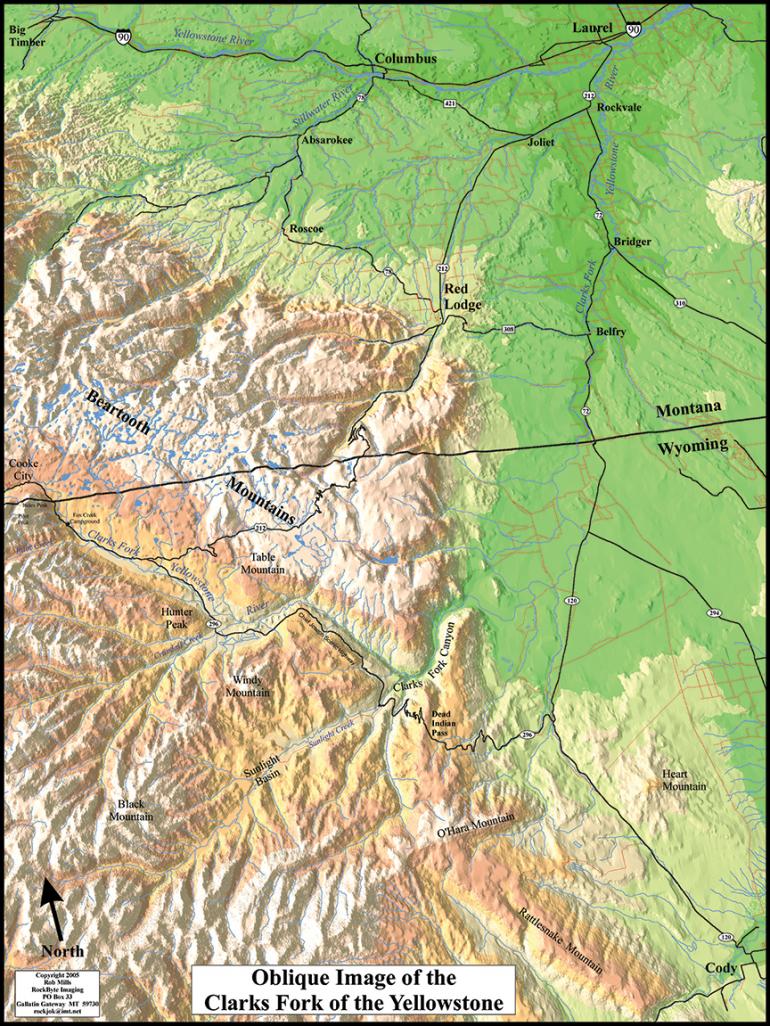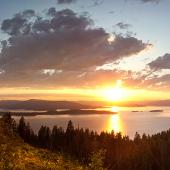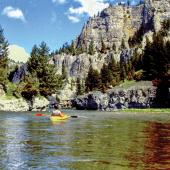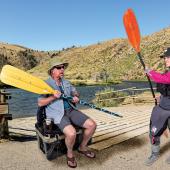Paddler's Dreamland
The Clark's Fork of the Yellowstone.
Down in the cool waters,
through swirling pools
above thunderous falls
between giant polished boulders
and soaring canyon walls
we are at once immersed in angelic beauty
and at peace with the pulse of a beast.
—J.P. Perdarder
The Clark’s Fork of the Yellowstone begins its tumultuous descent from the Absaroka-Beartooth Wilderness just outside the northeast entrance to Yellowstone National Park. On the way to its confluence with the Yellowstone River near Laurel, Montana, the Clark’s Fork tumbles through a feral and remote section of Wyoming’s Shoshone National Forest, including 20.5 miles of federally protected Wild and Scenic River known as the Box Canyon. Supporting abundant wildlife and the highest concentration of grizzly bears in the lower 48, this rugged area has remained in pristine condition, thanks in part to the hard work of the many environmental groups who banded together in the mid-90s to stop the New World Mine project. (We are forever indebted...)
While excellent hiking along the North Rim, blue-ribbon trout fishing, and the scenic vistas from the Chief Joseph and Dead Indian highways draw many visitors to the river and its breathtaking canyon each year, there is a facet of the Clark’s Fork that few people have experienced. This secluded area is blessed with fantastic whitewater opportunities for the advanced and expert kayaker, with good flows extending well into the dry summer months. From just outside Cooke City to the terminus of Clark’s Fork Canyon Road are six excellent whitewater runs ranging from a two-hour, Class IV cruise, to a two-day Class V-V+ epic.
Stix and Stones
The highwater horror stories of an experienced crew from Jackson Hole kept this remarkable Class V+ run quiet for several years. In 2001, Tyler and Travis Tollefson put in here and found several stunning drops tucked into the secluded five-mile run between the Chief Joseph Trailhead and the Fox Creek Campground. The rapids are short and extremely steep with several clean waterfalls ranging from 12-25 feet. All the major drops are high-quality and definitely deserve their V+ rating. Though never more than a couple of miles from the road, this run boasts a very remote feel.
The sound of approaching whitewater should be treated with caution throughout this run, as there are several mandatory portages of life-threatening cascades and gnarly sieves. As with all sections of the mighty Clark’s Fork, it would be easy to drop one eddy too far and find yourself in a very unpleasant situation. So, scout often. With the exception of the final half-mile—consisting of very fast and continuous Class IV-V—this stretch is the epitome of pool-drop character. Between the chaotic drops, pure mountain waters fill deep, emerald green pools teeming with trout. Cliff walls of broken granite and dense green forest line the shore and jagged peaks can be seen towering above the treetops. This is classic grizzly country, so keep your eyes peeled.
There is a price to pay for the great waterfalls and superlative views, however. Portages are numerous, and the only things thicker than the underbrush are the ferocious swarms of blood-sucking mosquitoes. Stix and Stones is truly a grand adventure. Go early, expecting stout drops, gorgeous landscapes, and constant adversity. You will be amply rewarded.
Day Stretch / Upper Clark’s Fork
The Day Stretch is the most commonly paddled section of the Clark’s Fork. It can be run at substantially higher flows than the other sections and the shuttle is a breeze. Views of Yellowstone’s Pilot and Index peaks are outstanding from the put-in, and the run is beautiful throughout, passing a few cabins but staying away from the road at all times. Shortly below the put-in lies a nasty drop known as Coin Slot (V+), a powerful pour-over funneling into an extremely tight slot, with most of the river’s flow flushing beneath the slot walls. This has been run at select (read: low) levels, though it is almost always portaged. Scout from the left, far above the drop.
Below Coin Slot are several enjoyable Class IV rapids and an exceptional play wave before the river begins its charge into the aptly named Adrenaline (V-V+). A long, convoluted approach studded with waves and holes leads to a compression pour-over with a very sticky hole followed immediately by a 30-foot, low-angled slide. The rocks surrounding the pour-over are extremely undercut and sieved out, so plan on staying in the boat for all 15 rounds. I’ve heard that seeing Adrenaline’s undercuts and sieves at low flows will keep most boaters from paddling it again. Scout and set safety on river left. The river tapers off after Adrenaline, becoming a straightforward float to the bridge near the Painter Store.
Offering a taste of the Clark’s Fork character, clean Class IV drops, and a scout/portage of two full-fisted Class V features, the Day Stretch is always a good time and makes an ideal starting point for kayakers looking to break into expert-level whitewater.
Honeymooner
This section is the classic pool-drop day run in the Greater Yellowstone area. Considered the warm-up for teams planning a trip down the infamous Box Canyon, the Honeymooner is a standout run in its own right. Peppered with great Class V rapids and large features, it’s the genesis of a long list of epic carnage stories forged in the depths of what is, in fact, the beginning of the Clark’s Fork Box.
Scouting the major drops from the confines of the deepening canyon can be rather tricky, and the clean lines are nearly impossible to spot from the boat—so it’s wise to paddle with someone familiar with this section on your first trip down. About a mile below the bridge at the Painter Store, the river begins to gorge up near a high cliff wall on river left. Below this Class IV drop, the action picks up substantially, dropping over 250 feet in the next two-and-a-half miles. After several tight, powerful Class IV-V rapids, you’ll see Beartooth Creek cascading into the Clark’s Fork from river left. The river is gorged up in this section and the scene is quite picturesque.
Below here lie two very dangerous and oft-portaged rapids. As the river bends hard left over shoals, paddle aggressively to the left bank to scout Big Nasty and Trixie. These back-to-back Class V-V+ drops are the crux of the run and their fine lines leave little room for error. One tough rapid remains at the confluence with Crandall Creek before the search for the somewhat elusive take-out begins. If you or members of your party are unsure where the take-out is, stay off this stretch! The consequences of missing the take-out are life-threatening.
While the rapids are outstanding, and the scenery exquisite, Honeymooner is a much less forgiving piece of whitewater than the Day Stretch. I would strongly recommend running Adrenaline with a smile on your face before committing to this run.
Crandall Creek
From the Bridge over Crandall Creek, every paddler’s eye is immediately drawn to the churning waters funneling into a five-foot-wide, 25-foot-long chasm carved through solid granite. Though routinely portaged, this is a most impressive drop and an exciting way to kick off a run down this oft-overlooked gem.
A tributary of the Clark’s Fork, Crandall Creek is the Box’s baby brother. Throughout the run, sheer, 60-foot cliff walls tower overhead, closing to less than a boat’s length in several places before reaching the confluence with the Clark’s Fork. The water is crystal clear, vacillating between a rich turquoise and the deep greens of the large pools. Though the whitewater tops out at class IV+, scouting all blind drops is advised, as some lines could prove disastrous. The rapids are unique and evenly spaced, providing a great opportunity for solid Class III-IV boaters to add some new tricks to their bag.
Crandall Creek is an outstanding intermediate run for the up-and-coming creek-boater, sporting fewer objective hazards and a much lower volume than other sections of the Clark’s Fork. It can easily be combined with the Day Stretch or Honeymooner for a full day of diverse whitewater.
The Box
Shrouded in lore and mystery, the Box Canyon of the Clark’s Fork of the Yellowstone is one of the definitive multi-day Class V kayaking trips in North America. It’s also one of the most dangerous. The third-deepest canyon in the United States and by far the least accessible, the Box is home to uncountable sieves, undercuts, and powerful cascades on the grandest of scales.
In places, sheer granite walls 1,200 feet high rise dramatically from tumbling Class V waters. Scouting from shore, one cannot apprehend the spectacle at a glance; it’s simply too immense. The roaring waters and silent stone are in perfect harmony here, singing a secret few have shared. It is like no other place on Earth.
The steep and demanding rapids found deep in the gorge are pure bliss for the intrepid kayaker. Coupled with the unparalleled aesthetics of the canyon itself, the entire experience leaves little to be desired. The knowledge that escape on foot is impossible for nearly the entire length of the run adds a level of intensity rarely found in kayaking.
Though hiking around the numerous mandatory portages is painstaking work, it’s well worth the effort as each offers a surreal view of powerful, raw elements churning and crashing in a humbling display of ferocity. The Box is an epic in all regards. Its grandeur will forever elude eloquence and imagery.
In August 2003, a group of seven paddlers (myself included) dropped below the Last Chance eddy above the sixth and final portage. Coming down an easy slide to a blind corner, we realized our mistake too late. All seven boaters were flushed into a terrible, un-runnable cascade laced with caves, sieves, and undercuts. Daniel Louis Crain, a great man, was lost. Though several members of the team had not been through the Box before, three of us had made the portage a combined five times—yet not one of us remembered the spot.
Clearly, the Clark’s Fork Box is not to be taken lightly. An experienced group of solid boaters, with their guard down momentarily, can be met with disaster in the blink of an eye. Do your homework and exercise extreme caution if you choose to pursue this run.
The Lower
This is actually the last three miles of the Box run. The Lower is good, continuous Class IV and can be a real riot when the water is high. The rapids are all easily scoutable from the road and stopping at will while on the river is possible at most flows. The drops have a big-water feel and are enjoyable, though of a completely different character than the runs upstream. The scenery is still fantastic, with the river exiting from a mountain canyon and blending seamlessly into a desert canyon before spilling out onto the plains. There are great camping spots in the area. The shuttle road will rip the guts out of an ordinary vehicle, so make sure your rig is stout and has excellent clearance.
For paddlers who have paid their dues on the wealth of class III-IV+ rivers in the Greater Yellowstone Area, the Clark’s Fork is a logical next step and an excellent reward for the time spent gathering experience on the water. It is an incredibly beautiful and readily accessible river system that sees much less impact from tourism than other locations in and near the Park. The near-perfect progression of advanced and expert runs in this drainage makes it one of the great launch pads in the region for up-and-coming boaters, but the consequences of pushing limits too far on this river are dire. Hang around enough riverside campfires and you are sure to hear epic tales of both triumph and tragedy on the legendary Clark’s Fork of the Yellowstone. The beauty, the danger, the incredible whitewater… this is a river of many extremes and should be treated with the utmost of respect at all times. Come prepared, and play hard. You won’t be disappointed.

